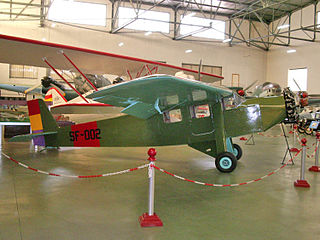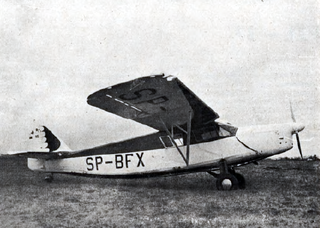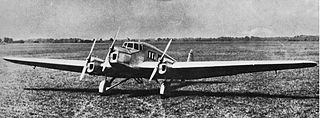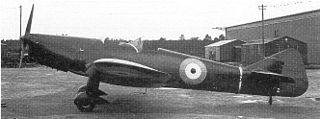
The RWD 5 was a Polish touring and sports plane of 1931, a two-seat high-wing monoplane, constructed by the RWD team. It was made famous by its transatlantic flight, being the smallest aircraft to cross the Atlantic.

The Farman F 400 was a 1930s French three-seat cabin high-winged monoplane which was designed and built by Farman.

The RWD-15 was a Polish touring aircraft of 1937, designed by the RWD team and built by the Doświadczalne Warsztaty Lotnicze (DWL).

The Chrislea Super Ace is a 1940s British four-seat light aircraft built by Chrislea Aircraft Limited.

The Potez 43 was a family of French light utility and sports aircraft, developed in early 1930s. They were three-seat single-engine high-wing monoplanes.

The Potez 58 was a family of French light utility and touring aircraft, developed in mid-1930s. They were three-seat single-engine high-wing monoplanes.

The Farman F.430 was a 1930s French light transport designed and built by the Farman Aviation Works. Two variants with different engines were known as the F.431 and F.432.

The Fiat G.2 was an Italian three-engine six-passenger monoplane transport aircraft designed by Giuseppe Gabrielli and built by Fiat.

The SAIMAN 202 was a 1930s Italian two-seat cabin monoplane designed and built by the Società Industrie Meccaniche Aeronautiche Navali (SAIMAN).

The Miles M.15 was a 1930s British single-engined monoplane trainer aircraft with two open cockpits, designed and developed by Miles Aircraft. Like other aircraft constructed to the official specification, it failed to meet the performance requirements, and only two were built.

The González Gil-Pazó GP-1 was a single-engine, two-seat open cockpit training aircraft, built in Spain in the 1930s to compete for a government contract. Declared the winner, production was curtailed by the Spanish Civil War. Two cabin variants, the González Gil-Pazó GP-2 and GP-4, were also built.

The Morane-Saulnier MS.341 was a single engine parasol wing training and touring aircraft built in France in the mid-1930s. It had two open cockpits in tandem and was sold to private owners, clubs and the Armée de l'Air.
The Bernard SIMB AB 10 was a French single-engine, single-seat, highly streamlined, cantilever, all-metal low-wing monoplane of advanced design. It first flew in 1924 but was not ordered into production.

The Bernard 60 T and 61 T were closely similar, three engine, twelve seat passenger transports designed in France between 1929 and 1933. They were not a success and only one of each was built.
The Bernard 80 GR was one of three types built by different French constructors in response to a government call for an aircraft capable of setting new long-distance records. A single engine monoplane with a crew of two, the 80 GR set an absolute record for flight over a closed circuit in April 1931, covering 8,960 km (5,569 mi). Modifications led to a new designation as the Bernard 81 GR but no more records were set despite several attempts.

The Koolhoven F.K.47 was a 1930s one-off two seat biplane designed and built in the Netherlands for an individual customer as a sport and touring aircraft.

The Koolhoven F.K.54 was a Dutch single-engine, three-seat touring aircraft with a retractable undercarriage. It flew shortly before the start of World War II and its development was abandoned after its first flight as attention turned to military aircraft.
The Bloch MB.90 was the first all-metal French light aircraft. Only two aircraft were completed, making their first flights in 1932, though there were several variants.
The unsuccessful French Farman F.200 of 1923 shared its type name with the 1929 Farman F.200, the progenitor of a series of parasol wing tourers. It was a two-seat touring aircraft, with a low, thick, cantilever wing. Only one was built and only briefly tested.

The Cairns A was a low wing, two tandem seat monoplane with a metal structure and stressed metal skin. It first flew late in 1931 with a 90 hp (67 kW) engine but was later fitted with more powerful engines including a 185 hp (138 kW) radial.
















